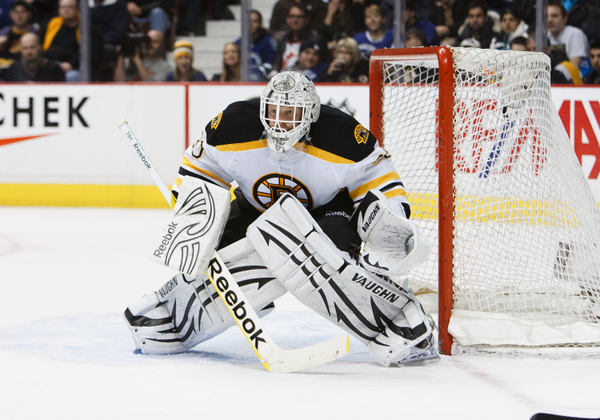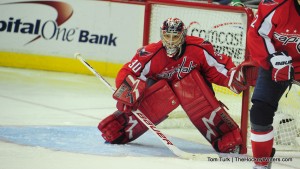
The second-seed Boston Bruins will face off against the seventh-seed Washington Capitals on Thursday in TD Garden. There, the Bruins hope to start their title-defense with a bang and the Caps seek to take advantage of the reduced pressure of underdog status to start the Stanley Cup playoffs successfully.
After discussing the B’s and Caps’ shared history on Sunday in Part I and evincing the significant (at least on-paper) advantage for Boston at even-strength yesterday in Part II – today, we’ll examine the special-teams and goaltending matchups.
The Bruins’ Powerplay vs. the Capitals’ Penalty-Kill
The Bruins haven’t struggled quite as much on the powerplay as in recent seasons – but they run hot and cold, which isn’t exactly conducive to success in the high-pressure atmosphere of postseason hockey. Of their 42 powerplay goals, 18 have come in 8 games with the remaining 24 spread out over 72 games. Twice they’ve gone six games without a man-advantage tally.
Still, the Bruins powerplay success-rate (17.3%, 14th) implies that the B’s aren’t too shabby up a man. However, they’ve only accrued 243 opportunities (sixth worst) and taken 318 shots (fourth worst) on the man advantage. No team received fewer powerplays after the first period than the Bruins. As a result of these deficiencies, no Bruin is ranked higher than fiftieth in the League in powerplay points – and no forward on the team is ranked above seventy-fifth.
All that said, the B’s have some tremendous talent on the man-advantage. They have two superb triggermen from the point (Brian Rolston and Zdeno Chara) and some real talent on both units. Rich Peverley looked solid in a PP QB role in the second-half and both David Krejci and Tyler Seguin are dangerous commanders from the half-wall. The Black and Gold have allowed the fewest shorthanded goals against (one) in the NHL.
The Capitals penalty kill falls short of the ideal in many ways. It’s fairly passive (evidenced by their three shorthanded goals), sits in the bottom-third of the League in success rate (81.6%, 21st) and gets significantly worse on the road (sub-80%). Despite their shorthanded difficulties, Capitals held the B’s to just one powerplay goal on eight man-advantage opportunities this season – the lone man-advantage marker coming off the stick of Brad Marchand.
The defensive trio of Karl Alzner, Dennis Wideman and John Carlson along eat up the majority of time on the back-end shorthanded while Brooks Laich, Troy Brouwer and Jeff Halpern are their top forwards on the PK. None of the Caps’ top PK-ers have had much success preventing shots on the man-disadvantage – and they’ve found similar trouble preventing goals (Jeff Halpern’s on-ice goals-against rate in shorthanded situations is almost comical).
In the end, something will have to give – the Bruins’ inability to get on the powerplay or the Capitals’ inability to complete the kill – and while we like the personnel matchup to favor the Bruins, their inconsistency leads us to expect to see some difficulties on the man-advantage again. If they struggle early (as in 2011) it’ll become a story once again and frustration could set in.
Slight Advantage: Washington
The Capitals’ Powerplay vs. the Bruins’ Penalty-Kill
The Capitals had only modest successes on the powerplay in 2011-12. Like the Bruins, they’ve been feast or famine (going ice cold during two seven-game stretches without a PPG three five-game streaks). Washington had a hard time drawing penalties (fourth worst in the League). Even so, their 16.7% success rate is far from abysmal, and the Caps have numerous weapons.
Alex Ovechkin, Nick Backstrom and Dennis Wideman all had considerable success on the powerplay this year for Washington. Ovechkin was tied for fifth in the NHL with thirteen man-advantage markers. Despite playing just over half the season, Backstrom finished tied for fiftieth in powerplay points with nineteen (and had more per-game than all but Sidney Crosby and Claude Giroux). Dennis Wideman’s twenty points on the powerplay were top-ten among defensemen.
Considering that Mike Green and Alex Semin both had ‘off’ years in 5-on-4 play (but each remains a dangerous powerplay weapon) that 16.7% is starting to look scarier and scarier. Still, only three teams allowed more shorthanded goals than Washington and against the B’s aggressive kill (8 SHG) that might be problematic.
The B’s penalty kill wasn’t particularly successful in 2011-12, but they wound up eleventh in the League at 83.5%. However, that rate would undoubtedly be higher, if the Bruins hadn’t surrendered a league-high eight goals in five-on-three situations. It’s notable that only four teams surrendered fewer 4-on-5 goals than the Bruins (34) in 2011-12.
The Bruins are by far the best faceoff-taking squad in the League and have two utterly dominating centers at the dot (Rich Peverley and Patrice Bergeron) – both of whom see considerable time in shorthanded situations. The B’s have seven plus-penalty-killing forwards in their lineup which takes the burden off any single individual to bear the brunt of the shorthanded pressure. Defensively, the B’s rely on their captain along with Dennis Seidenberg and Johnny Boychuk to prevent attackers from getting too comfortable.
The Bruins were the more successful unit this season and were more than a little snake-bit thanks to those aforementioned five-on-three tallies against. Washington has many players with dynamic capabilities but the B’s are very capable of shutting a first unit down with Chara & Co. The pressure will be on the Caps’ second unit to find the back of the net. The B’s held them to just one powerplay goal on six chances this season (coming off the stick of Brooks Laich on a mid-slot re-direction); expect that kind of success to continue in the quarterfinal series.
Slight Advantage: Boston
The Goaltender Matchup
That Tim Thomas’ 2011-12 season has been far less successful than his 2010-11 campaign goes without saying. Still, his .920 Sv% and 2.36 GAA put him just outside the NHL’s top-10 and his 35 wins tied him for fifth in the League.
The Caps’ Tomas Vokoun re-injured his groin on March 29 against the B’s and is reportedly done for the season. Even more problematic, young backup Michal Neuvirth hurt his left leg in the Caps’ matchup with Florida on Thursday. The injury is being called ‘day-to-day’ but for now, Braden Holtby is the Capitals’ starting netminder and journeyman AHLer (and former P-Bruin), Dany Sabourin is the backup.
Neuvirth has taken a step back in this, his second full season with the Capitals. Posting just 13 wins in 30 starts along with a poor goals against average (2.82) and save percentage (.903), one begins to wonder if the Caps are better off with Holtby in net, after all. A veteran of just 21 NHL games (and just seven this year), Holtby has a .929 Sv% and a 2.02 GAA and fourteen wins.

In Neuvirth’s lone playoff action (2011 against the Rangers and Bolts), he performed admirably. He tallied four wins and a shutout before Tampa so unceremoniously swept the Caps out of postseason play.
Holtby has yet to take the ice in the Stanley Cup playoffs, but there are more than a few well-respected voices in D.C. who believe the kid has what it takes. Before folks start talking Ken Dryden, there’s a number worth sharing: .881 – that’s Holtby’s save percentage in nine postseason games at the AHL level.
Regardless of who takes to the crease for the Caps, Thomas is in a different class altogether. While both project as talented and solid starters certainly capable of stealing a playoff series, Thomas remains a world-class netminder and rumors of his fall from elite standing are premature.
Sure, there are legitimate knocks on Thomas (that don’t involve Presidential snubs) foremost among these is that his overly-aggressive play puts him out of position and vulnerable to second-chances. However he’s equally prone to making outstanding saves, tracks the puck through screens as well as anyone and plays his best on the biggest stage: He’s 26-17 with a .935 Sv% and a 2.06 GAA in the playoffs and was the deserving recipient of certain piece of leaf-adorned hardware last June .
One area of concern for the Bruins and Thomas has to be his career history against the Caps – despite a solid 14-5-3 record, he’s accrued a 2.46 GAA and .923 Sv% – not outlandish numbers by any stretch of the imagination but still a step below his career averages.
In the end, Thomas’ outstanding clutch resume gives the B’s the edge in net over whomever the Caps start in game one. The Bruins also have a major advantage in backups (a healthy Tuukka Rask is arguably the best #2 in the game…) though Rask hasn’t played in well over a month. After his performance against Ottawa on Thursday, one might be tempted to give Anton Khudobin the edge over Sabourin if not Holtby.
Significant Advantage: Boston
In the next installment (Part IV)of our Capitals-Bruins Breakdown, we’ll examine the coaching matchup, injuries, intangibles and the key players for the series. The Preview concludes with Part V, laying out the keys to the series and making a final prediction.